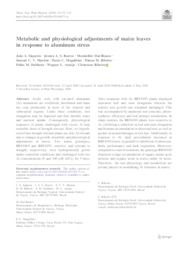Metabolic and physiological adjustments of maize leaves in response to aluminum stress.
Metabolic and physiological adjustments of maize leaves in response to aluminum stress.
Autoria: SIQUEIRA, J. A.; BARROS, J. A. S.; DAL-BIANCO, M.; MARTINS, S. C. V.; MAGALHAES, P. C.; DAMATTA, F. M.; ARAÚJO, W. L.; RIBEIRO, C.
Resumo: Acidic soils with elevated aluminum (Al) saturations are worldwide distributed and harm the crop production in most of the tropical and subtropical regions. Under these conditions, root elongation may be impaired and thus disturbs water and nutrient uptake. Consequently, physiological responses of plants challenged with excess Al may resemble those of drought stresses. Here, we hypothesized that drought tolerant plants are also Al tolerant due to changes in growth, metabolic and physiological adjustments in leaves. Two maize genotypes, BRS1010 and BRS1055, sensitive and tolerant to drought, respectively, were hydroponically grown under controlled conditions and challenged with two Al concentrations (0 and 100 µM AlCl3) for 5 days. After treatment with Al, BRS1055 plants displayed increased leaf and stem elongation whereas the relative root growth rate remained unchanged. This was accompanied by unaltered root structure, photosynthetic efficiency and leaf primary metabolism. In sharp contrast, the BRS1010 plants were sensitive to Al, exhibiting a reduction in leaf and stem elongation and biomass accumulation in shoot and root, as well as greater structural damages in root tips. Additionally, in response to Al, lipid peroxidation increased in BRS1010 leaves in parallel to inhibition of photosynthetic performance and dark respiration. Moreover, compared to control treatment, the genotype BRS1010 displayed a large accumulation of sugars, amino acid, proteins and organic acids in leaves under Al stress. Therefore, the leaf physiology and metabolism are pivotal players in modulating Al tolerance in maize. © 2020, Brazilian Society of Plant Physiology.
Ano de publicação: 2020
Tipo de publicação: Artigo de periódico
Unidade: Embrapa Milho e Sorgo
Observações
1 - Por padrão são exibidas publicações dos últimos 20 anos. Para encontrar publicações mais antigas, configure o filtro ano de publicação, colocando o ano a partir do qual você deseja encontrar publicações. O filtro está na coluna da esquerda na busca acima.
2 - Para ler algumas publicações da Embrapa (apenas as que estão em formato ePub), é necessário ter, no celular ou computador, um desses softwares gratuitos. Sistemas Android: Google Play Livros; IOS: iBooks; Windows e Linux: software Calibre.
Acesse outras publicações
Acesse a Base de Dados da Pesquisa Agropecuária (BDPA) para consultar o acervo completo das bibliotecas da Embrapa.

